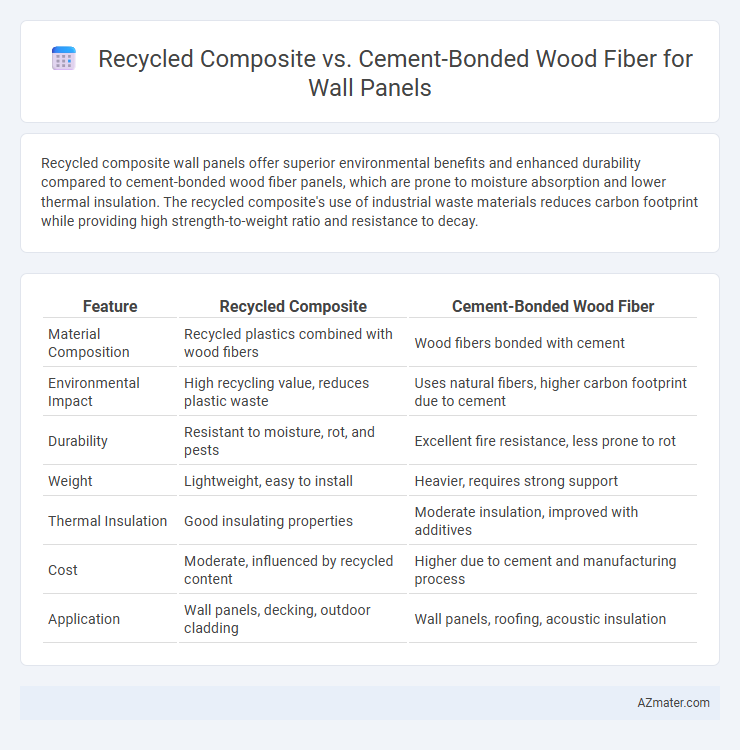Recycled composite wall panels offer superior environmental benefits and enhanced durability compared to cement-bonded wood fiber panels, which are prone to moisture absorption and lower thermal insulation. The recycled composite's use of industrial waste materials reduces carbon footprint while providing high strength-to-weight ratio and resistance to decay.
Table of Comparison
| Feature | Recycled Composite | Cement-Bonded Wood Fiber |
|---|---|---|
| Material Composition | Recycled plastics combined with wood fibers | Wood fibers bonded with cement |
| Environmental Impact | High recycling value, reduces plastic waste | Uses natural fibers, higher carbon footprint due to cement |
| Durability | Resistant to moisture, rot, and pests | Excellent fire resistance, less prone to rot |
| Weight | Lightweight, easy to install | Heavier, requires strong support |
| Thermal Insulation | Good insulating properties | Moderate insulation, improved with additives |
| Cost | Moderate, influenced by recycled content | Higher due to cement and manufacturing process |
| Application | Wall panels, decking, outdoor cladding | Wall panels, roofing, acoustic insulation |
Introduction to Sustainable Wall Panel Materials
Recycled composite materials for wall panels provide enhanced durability and moisture resistance while utilizing post-consumer or industrial waste, significantly reducing environmental impact. Cement-bonded wood fiber panels combine wood fibers with cement to deliver fire resistance, thermal insulation, and soundproofing properties, making them a sustainable alternative in construction. Both materials contribute to green building certification goals by improving energy efficiency and minimizing carbon footprint through resource conservation and waste reduction.
Overview of Recycled Composite Panels
Recycled composite panels for wall applications are manufactured from post-consumer and industrial waste materials, offering significant environmental benefits through resource recovery and waste reduction. These panels exhibit enhanced durability, moisture resistance, and thermal insulation compared to traditional cement-bonded wood fiber panels, making them suitable for sustainable construction. Their lightweight nature and improved mechanical properties contribute to easier installation and long-term performance in residential and commercial wall systems.
Understanding Cement-Bonded Wood Fiber Panels
Cement-bonded wood fiber panels combine wood fibers with Portland cement to create a lightweight, durable, and fire-resistant material ideal for wall panel applications. These panels offer superior moisture resistance and dimensional stability compared to recycled composite panels, making them suitable for exterior and high-humidity environments. High compressive strength and thermal insulation properties of cement-bonded wood fiber panels contribute to enhanced building performance and energy efficiency.
Material Composition and Manufacturing Processes
Recycled composite wall panels typically consist of reclaimed plastic and wood fibers, combining sustainable waste materials through extrusion or compression molding to achieve enhanced durability and moisture resistance. Cement-bonded wood fiber panels integrate wood fibers with Portland cement, using hydraulic pressing and curing processes that produce rigid, fire-resistant panels with higher compressive strength. The manufacturing of recycled composites emphasizes environmental benefits and flexibility, while cement-bonded panels prioritize structural integrity and longevity in exterior wall cladding applications.
Comparative Structural Performance
Recycled composite wall panels demonstrate superior tensile strength and enhanced durability compared to cement-bonded wood fiber panels, offering increased resistance to moisture and impact. Cement-bonded wood fiber panels provide higher compressive strength and better fire resistance due to their mineral content, making them suitable for load-bearing applications. The choice between these materials depends on the balance required between flexibility, structural load capacity, and environmental exposure in the intended wall panel application.
Insulation and Thermal Properties
Recycled composite wall panels exhibit superior insulation with low thermal conductivity, improving energy efficiency in building envelopes by reducing heat transfer. Cement-bonded wood fiber panels provide enhanced thermal mass, stabilizing indoor temperatures through heat absorption and release, which is beneficial for temperature regulation in variable climates. Both materials offer sustainable insulation solutions, but recycled composites generally outperform cement-bonded wood fibers in minimizing thermal bridging and maintaining consistent thermal resistance.
Environmental Impact and Sustainability
Recycled composite wall panels significantly reduce environmental impact by repurposing waste materials, lowering landfill contributions and conserving natural resources compared to cement-bonded wood fiber panels, which rely on high-energy cement production with associated CO2 emissions. The sustainable advantage of recycled composites is enhanced by their potential for circularity and reduced embodied carbon, whereas cement-bonded wood fiber panels, although durable, involve resource-intensive manufacturing processes that impact sustainability. Life cycle assessments consistently show recycled composite materials achieve a lower carbon footprint and reduced water usage, supporting greener building practices in sustainable construction.
Cost and Economic Considerations
Recycled composite wall panels typically offer lower material costs due to the use of repurposed waste, reducing expenses related to raw materials and landfill fees. Cement-bonded wood fiber panels, while generally more expensive upfront, provide greater durability and fire resistance, potentially lowering long-term maintenance and replacement costs. Economic considerations must balance initial investment with lifecycle savings, factoring in local material availability, labor costs, and environmental incentives for sustainable construction materials.
Applications and Design Flexibility
Recycled composite wall panels offer superior environmental benefits and are ideal for applications requiring high durability and moisture resistance, such as exterior cladding and wet area partitions. Cement-bonded wood fiber panels provide excellent fire resistance and structural stability, making them suitable for load-bearing walls and acoustic partitions in commercial and residential buildings. Both materials allow customizable designs, with recycled composites supporting color and texture variations, while cement-bonded panels excel in moldable shapes and integration with other construction elements.
Conclusion: Choosing the Right Wall Panel Solution
Recycled composite wall panels offer enhanced durability, moisture resistance, and sustainability due to their use of reclaimed materials and advanced binding agents. Cement-bonded wood fiber panels provide superior fire resistance, thermal insulation, and dimensional stability, ideal for environments requiring robust performance. Selecting the right wall panel depends on balancing environmental impact, structural requirements, and specific application needs to achieve optimal long-term performance.

Infographic: Recycled composite vs Cement-bonded wood fiber for Wall panel
 azmater.com
azmater.com